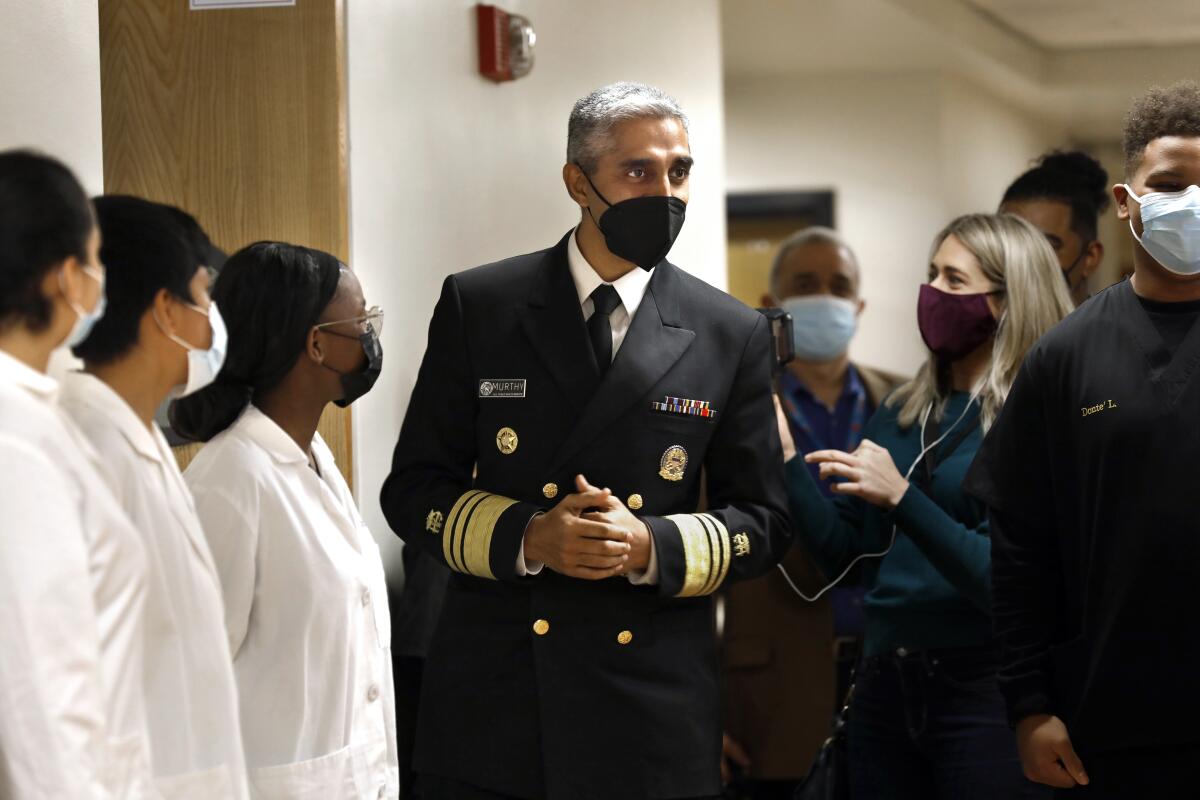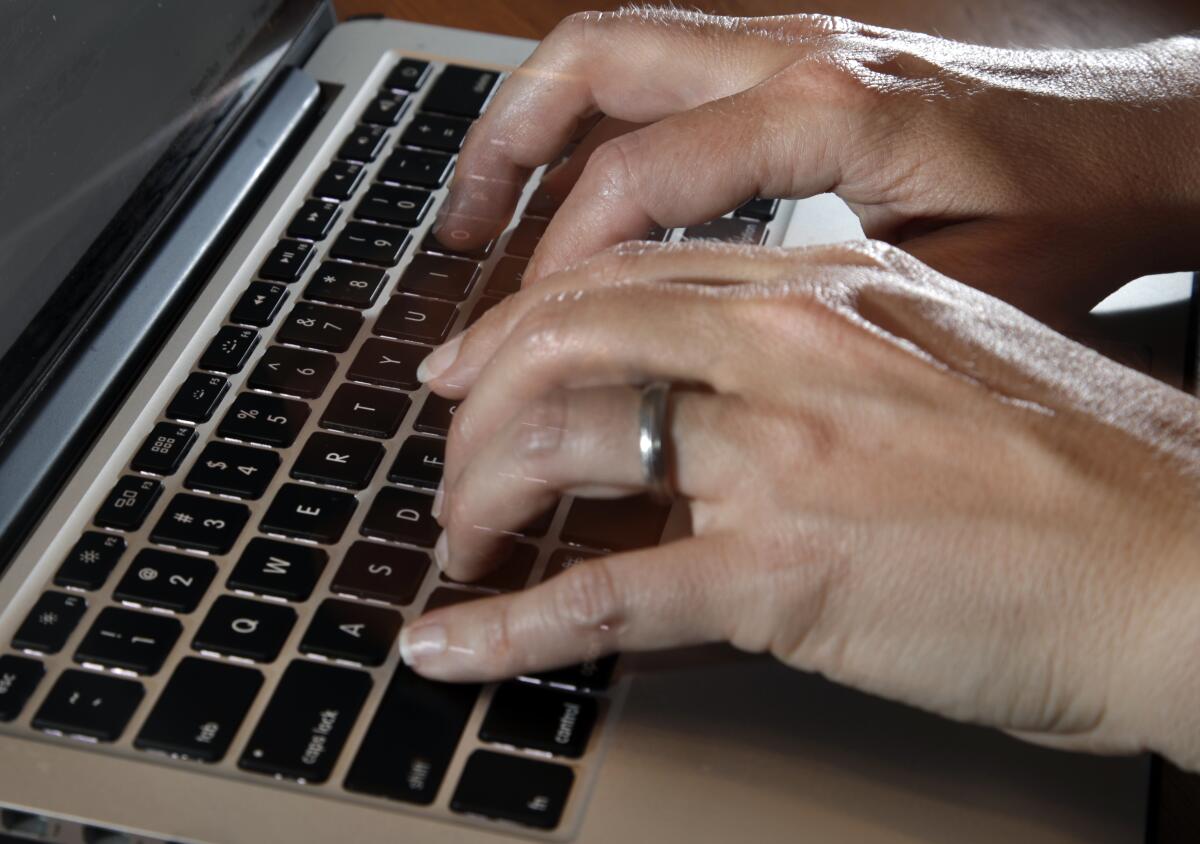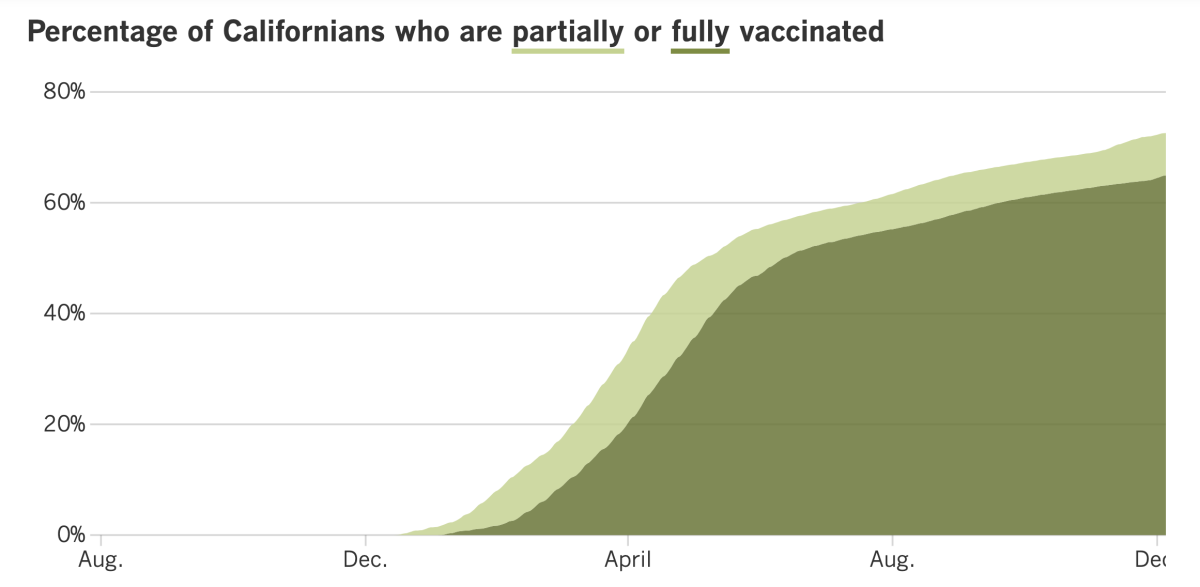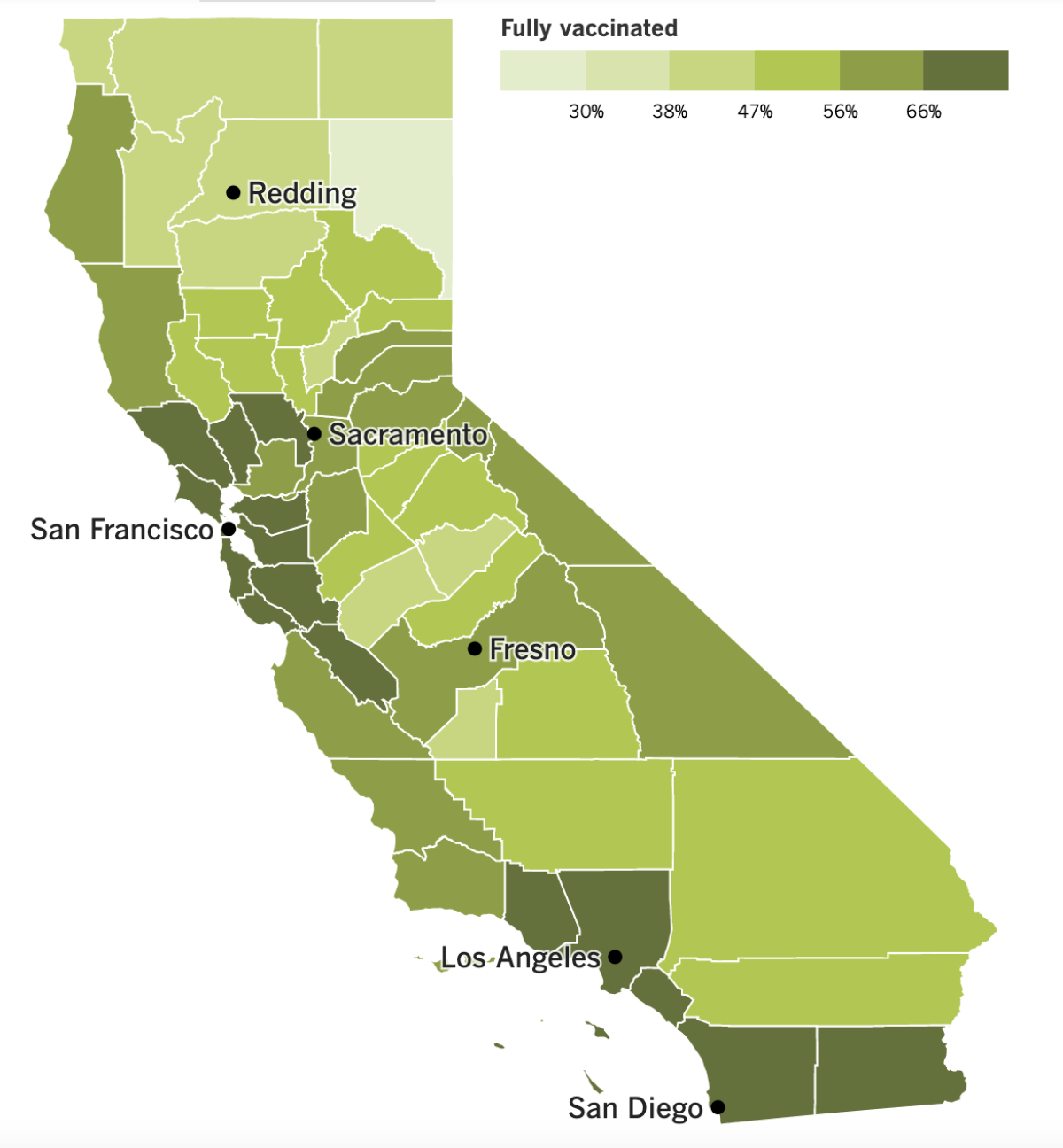Coronavirus Today: Preventing one health crisis from spawning another
Good evening. Iâm Karen Kaplan, and itâs Tuesday, Dec. 7. Hereâs the latest on whatâs happening with the coronavirus in California and beyond.
Sydnee Breda-Nixon is a 17-year-old senior at King/Drew Magnet High School of Medicine and Science in the Willowbrook area of South Los Angeles. The school is full of high achievers, and its next-door neighbor is a regional medical center and medical school. But that wasnât enough to insulate her from the effects of the pandemic â especially its effect on her mental health.
The global health emergency made everything feel dull and hopeless, she told my colleague Howard Blume. She lost interest in the activities she used to enjoy. Even the prospect of spending time with friends and family held little appeal â until her sister helped pull her out of it.
Sydnee is hardly the only student at her school to confront mental health challenges made worse by the pandemic. Nor is her school an outlier in that regard. Multiply her campus by the 130,000 or so schools across the country and youâve got the makings of a crisis.
If that sounds like some overwrought teenage angst, consider that 1 out of 4 children experienced depressive symptoms, and 1 in 5 suffered from anxiety, at some point during the pandemic. The incidences of both depression and anxiety have doubled since the coronavirus burst onto the scene.
Need more evidence? How about this: The number of adolescent girls who wound up in hospital emergency rooms after attempting suicide was 51% higher in early 2021 than it had been in early 2019. It was also 4% higher for adolescent boys.
Itâs enough of a crisis that U.S. Surgeon General Vivek Murthy issued a public health advisory on the mental health challenges confronting Americaâs youth. And itâs been exacerbated by the hardships thrust upon kids by the pandemic.
âIt would be a tragedy if we beat back one public health crisis only to allow another to grow in its place,â Murthy wrote in a preface to the advisory, which was released Tuesday.

Indeed, it has often seemed as if there is a direct trade-off between protecting public health and protecting mental health. Distance learning kept the coronavirus from spreading, but it also cut children off from their friends, teachers, school counselors and others. This isolation made it âharder to recognize signs of child abuse, mental health concerns, and other challenges,â according to the advisory.
Children from all backgrounds have been affected. But as usual with the pandemic, the effects have been uneven, with students of color, those from low-income families, immigrants and children with disabilities suffering more often.
Murthyâs advisory calls for an all-hands-on-deck response that goes beyond government agencies. Giving kids the help they need will require cooperation from community groups, social media companies, parents, teachers and schools, among others.
Hereâs one concrete suggestion: Professional guidelines recommend schools have one counselor for every 250 students. Nationwide, the average ratio during the 2019-2020 school year was one counselor for every 424 students.
Shortages like that used to be blamed on a lack of funds. Now, Blume writes, the money is available, but the professionals are not. So Murthyâs report calls on all levels of government to invest in a new generation of not just counselors but also social workers, nurses and school psychologists.
Murthy also says students can play an important role by helping one another. Simply being attentive to a friendâs change of mood or behavior can make a big difference by preventing a problem from growing into a catastrophe.
Sydnee is way ahead of him. She already makes a point of being there for her friends when they need her.
âI tend to notice when something is wrong,â she said, âwhether it be how theyâre texting, or how theyâre talking to me, or how theyâre reacting to certain things that Iâve done or said. If I see it on like Tuesday, Iâll ask them on maybe Wednesday â because you donât want to just let them go through it all by themselves, because then that becomes something that is hard to take on.â
By the numbers
California cases and deaths as of 4:42 p.m. on Tuesday:
Track Californiaâs coronavirus spread and vaccination efforts â including the latest numbers and how they break down â with our graphics.
Is your employer spying on you?
In February 2020, the month before the coronavirus triggered lockdowns across the U.S., Americans logged 5% of their work hours at home, on average. After the pandemic took hold, that figure climbed all the way up to 40%.
It might seem like a prime opportunity for playing hooky, especially in those early days when we devoted hours to wiping down all the food that came into our homes and searching for toilet paper online â not to mention all the time devoted to helping kids adjust to distance learning.
Yet the productivity of American workers actually increased during the pandemic. In fact, itâs grown more than twice as fast during the COVID-19 era as it did during the entire decade before.
Economists at Stanford and the University of Chicago talked to companies about the efficiency of their work-from-home workforces and learned that more than 85% of them said employees either met or exceeded their expectations. Half of them characterized the improvement as âsubstantiallyâ or âhugelyâ better.
So why are so many companies spying on their remote workers?
Maybe itâs because they can, my colleague Don Lee reports.
Itâs pretty straightforward to install monitoring software on company-owned computers that can keep track of workersâ keystrokes, see which websites theyâre visiting, and count the minutes theyâre active. The software can also take screenshots at regular intervals and activate a webcam to see whatâs really going on.
All this surveillance can be had for as little as $50 to $100 per employee per year.
About 60% of large companies now use monitoring software, according to estimates from Gartner, the technology research and consulting firm. In early 2020, only 30% did so.

Teramind is a Miami company that sells this type of software. The company told Lee that before the pandemic, about 30% of its sales were to employers concerned about worker productivity. Now, about 70% of sales (which have tripled) are motivated by productivity concerns.
âItâs essentially become the new norm,â said Eli Sutton, Teramindâs vice president of operations.
Sound Orwellian? That may explain why so many companies brushed off Leeâs requests to talk about why they use the software. That list includes Verizon, Keller Williams and Vonage.
And to make things even creepier: Some companies are monitoring workers without their knowledge. A study this spring found that 20% of employers who used the software hadnât come clean with their employees.
The practice is generally legal, so long as the tracking occurs on company-owned equipment. But a few states are trying to change that. A bill under consideration in the Massachusetts Legislature would put checks on employee surveillance; another bill in Illinois would restrict how companies use the software to discipline workers.
If you work from home, youâre probably eager to find out whether your company is spying on you.
Good luck with that.
âUnfortunately ... thereâs no easy way for employees to find out if their employer is monitoring them,â Matt Scherer, senior policy counsel for worker privacy at the nonprofit Center for Democracy and Technology, told my colleague Arit John.
Californiaâs vaccination progress


See the latest on Californiaâs vaccination progress with our tracker.
Your support helps us deliver the news that matters most.
In other news ...
The Omicron variant has now been detected in 23 states, according to the Centers for Disease Control and Prevention. At least nine people in California have been infected with the new variant, including five from Alameda County who attended a wedding in Wisconsin over Thanksgiving weekend. Seven other wedding guests from Alameda County also came down with coronavirus infections, but officials havenât yet announced which variant was responsible for their cases.
One of the 12 wedding guests had recently returned from an international trip, county health officials said. All 12 of them were vaccinated, and most had received booster shots. The five with confirmed Omicron infections experienced mild symptoms of COVID-19.
Los Angeles County announced its second and third Omicron cases on Monday. One of them was a student at USC who had just returned from the East Coast; the other had recently traveled to western Africa. Both patients were vaccinated and had mild COVID-19 symptoms.
So far, none of the three L.A. County residents with Omicron appear to have spread it to others.
Officials in California are preparing for a possible second winter surge â one that may come from Omicron, the still-overwhelmingly-dominant Delta variant, or a combination of the two.
In L.A. County, for example, residents of skilled nursing facilities will have to be tested for coronavirus infections once a week between Dec. 15 and Jan. 31, regardless of their vaccination status. The same applies to employees and contractors who come into contact with residents.
Dr. Regina Chinsio-Kwong, a deputy health officer for Orange County, urged people to get vaccinated, get their booster shot and get tested regularly. She also suggested that people give serious thought to downsizing their plans for holiday celebrations and to think about holding them outdoors to reduce the risk further.
âIt is important for all of us to take precaution,â Chinsio-Kwong said, âas we see other states see a rise in cases, and we want to protect our loved ones.â
The San Joaquin Valley is finally getting a bit of a breather, with hospitalizations there now 30% lower than they were in mid-November. Even so, the hospitalization rate in Fresno County is more than triple the rate in L.A. County, and officials are expecting things to get worse this winter.
Unlike last year, there are no plans to set up cots in the Fresno convention center or any other alternative care sites, said Dr. Rais Vohra, the countyâs interim health officer. Instead, if hospitals become overwhelmed, doctors may be forced to implement crisis standards of care, which could involve rationing care and prioritizing patients who are most likely to survive.
In New York City, Mayor Bill de Blasio is hoping to head off a winter surge with a new vaccine mandate for employees of private businesses.
âWe in New York City have decided to use a preemptive strike to really do something bold to stop the further growth of COVID and the dangers itâs causing to all of us,â De Blasio said Monday on MSNBCâs âMorning Joe.â
The Big Apple already has mandates in place for city employees including teachers, police officers and firefighters, as well as for employees of hospitals, nursing homes, and private and religious schools. The new rule, which applies to about 184,000 businesses, will take effect Dec. 27 â if it survives expected legal challenges. De Blasio expressed confidence that it would.
He may need to temper his optimism. Over the weekend, a federal appeals court put a temporary hold on a similar vaccine mandate from the Biden administration. The federal mandate requires employees of businesses with at least 100 workers to be vaccinated by Jan. 4 ; those who donât will have to get tested weekly and follow mask rules.
The appeals court in New Orleans said it was delaying the vaccine requirement because its critics had raised potentially âgrave statutory and constitutional issues.â
Then on Tuesday, a federal district court in Augusta, Ga., issued a stay to prevent the vaccine mandate from being enforced anywhere in the country. The order applies nationwide because one of the challengers is a trade group that represents builders and contractors around the country.
At least 27 states have challenged the vaccine mandate in federal courts around the country, some of which are more conservative than others. Lawyers for the U.S. Department of Labor remain confident the agency has the authority to issue the vaccination rules, which were set forth by the Occupational Safety and Health Administration.
Back in L.A. County, more than one-quarter of Metro employees have missed a deadline to show proof that theyâve been vaccinated, raising questions about how the agency will be able to maintain crucial services without putting transit riders at risk.
Overall, 72% of Metro employees have shown that theyâre vaccinated. Some categories of workers have complied better than others; among operators and schedule checkers, only 58% have provided proof of vaccination.
âMetro has an obligation to provide and maintain a safe workplace,â Dave Sotero, the agencyâs communications director, said in a statement. âWe adopted a mandatory vaccination policy to safeguard the health of our employees and their families, our customers and the community at large from infectious diseases that vaccinations may reduce.â
John M. Ellis, a general chairman with the SMART transportation union that represents Metro bus and train operators, said the union was âknee-deep in negotiationsâ over how the vaccination rules would play out. âIâm sure weâll be reaching some kind of alternative to satisfy the requirement,â he said.
Just how far will some people go to avoid a COVID-19 shot? In Italy, a 57-year-old dentist tried to evade it by deploying a fake arm made of silicone.
The syringe-wielding nurse said she could tell right away that the limb was phony. âWhen I uncovered the arm, I felt skin that was cold and gummy, and the color was too light,â she told an Italian newspaper.
When confronted, the dentist admitted he was trying to obtain a health pass that would allow him to enter restaurants, cinemas, theaters and other venues in Italy. When his scheme failed, he left.
Although the man was courteous, the nurse and her colleagues reported him for fraud. Now the dentist may face criminal charges.
Your questions answered
Todayâs question comes from readers who want to know: If I donât have side effects after getting a COVID-19 booster shot, does that mean it didnât work?
No. Although itâs common for people to feel to feel ill after getting a booster â just like many did after getting their initial vaccine doses â itâs not necessary for the shot to do its job.
Researchers at Johns Hopkins University looked into the relationship between side effects and COVID-19 vaccine effectiveness, mindful that âanxiety can arise in persons who did not develop a reaction following vaccination,â they wrote in a study published in JAMA Internal Medicine.
They recruited 954 healthcare workers who agreed to have their blood drawn so their antibody levels could be checked. All but one of them â a person who was taking medication to suppress their immune system â developed antibodies after receiving two doses of an mRNA vaccine, and there was no link between vaccine side effects and antibody response.
Likewise, an examination of 67 healthcare workers in Japan who took the Pfizer-BioNTech vaccine also found no relationship between side effects and antibody production. That study was published in PLOS One.
If you didnât experience side effects, count yourself lucky.
Researchers at the CDC examined reports from more than 12,500 people who got a Pfizer-BioNTech booster during the first 5½ weeks it was available and found that 74.1% of them experienced systemic side effects, such as headache or fatigue, while 79.4% had problems like pain or soreness at the injection site.
Meanwhile, among 6,283 people who had a Moderna booster shot, 79% reported systemic side effects, and 84.7% had local side effects. Those findings were published in the CDCâs Morbidity and Mortality Weekly Report.
We want to hear from you. Email us your coronavirus questions, and weâll do our best to answer them. Wondering if your questionâs already been answered? Check out our archive here.
Resources
Need a vaccine? Hereâs where to go: City of Los Angeles | Los Angeles County | Kern County | Orange County | Riverside County | San Bernardino County | San Diego County | San Luis Obispo County | Santa Barbara County | Ventura County
Practice social distancing using these tips, and wear a mask or two.
Watch for symptoms such as fever, cough, shortness of breath, chills, shaking with chills, muscle pain, headache, sore throat and loss of taste or smell. Hereâs what to look for and when.
Need to get a test? Testing in California is free, and you can find a site online or call (833) 422-4255.
Americans are hurting in many ways. We have advice for helping kids cope, resources for people experiencing domestic abuse and a newsletter to help you make ends meet.
Weâve answered hundreds of readersâ questions. Explore them in our archive here.
For our most up-to-date coverage, visit our homepage and our Health section, get our breaking news alerts, and follow us on Twitter and Instagram.




